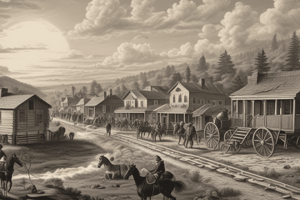Podcast
Questions and Answers
What was one significant consequence of the Articles of Confederation on statehood?
What was one significant consequence of the Articles of Confederation on statehood?
- It prohibited amendments from being passed.
- It allowed for direct elections of Senators.
- It facilitated the creation of new western states equal to older states. (correct)
- It established a strong federal government.
Which policy did Andrew Jackson support that aimed at expanding voting rights?
Which policy did Andrew Jackson support that aimed at expanding voting rights?
- Reinstatement of the electoral college.
- Universal white male suffrage. (correct)
- Opposition to state nullification of federal law.
- Direct election of US Senators.
What factor led to the outbreak of Bacon’s Rebellion?
What factor led to the outbreak of Bacon’s Rebellion?
- Desire for trade agreements with Native Americans.
- Frustration over lack of protection from Native Americans. (correct)
- Demand for increased rights for free laborers.
- Discontent with the British monarchy.
What was a key belief of Jeffersonian Republicans compared to Federalists?
What was a key belief of Jeffersonian Republicans compared to Federalists?
What was a major effect of the Mexican American War on the North and South?
What was a major effect of the Mexican American War on the North and South?
What was a significant reason for the Jeffersonian Republicans' hesitation to ratify the US Constitution?
What was a significant reason for the Jeffersonian Republicans' hesitation to ratify the US Constitution?
Which party emerged in response to anti-immigrant sentiments in the Northern United States during the 1800s?
Which party emerged in response to anti-immigrant sentiments in the Northern United States during the 1800s?
What document did the Seneca Falls Convention's Declaration of Sentiments model after?
What document did the Seneca Falls Convention's Declaration of Sentiments model after?
What was a significant outcome of the Emancipation Proclamation?
What was a significant outcome of the Emancipation Proclamation?
Which major issue in the lead-up to the Civil War was exacerbated by popular sovereignty?
Which major issue in the lead-up to the Civil War was exacerbated by popular sovereignty?
How did the Proclamation Line of 1763 aim to address conflicts between white colonists and Native Americans?
How did the Proclamation Line of 1763 aim to address conflicts between white colonists and Native Americans?
What happened to the privileges some slaves experienced after Nat Turner's Rebellion?
What happened to the privileges some slaves experienced after Nat Turner's Rebellion?
What was one of the outcomes of the 1836 Gag Resolution?
What was one of the outcomes of the 1836 Gag Resolution?
Flashcards
Manufacturing and the North's Economy
Manufacturing and the North's Economy
The growth of manufacturing in the North during the 1800s led to a larger middle class and a more diverse economy.
Anti-Immigrant Sentiment in the North
Anti-Immigrant Sentiment in the North
Anti-immigrant sentiment was stronger in the North during the 1800s because most immigrants settled there.
Jeffersonian Republicans and the Constitution
Jeffersonian Republicans and the Constitution
The Jeffersonian Republicans were wary of a strong central government, fearing it would infringe on individual liberties. The Bill of Rights helped address their concerns.
Slavery and Expansion
Slavery and Expansion
Signup and view all the flashcards
Popular Sovereignty and Slavery
Popular Sovereignty and Slavery
Signup and view all the flashcards
Emancipation Proclamation's Impact
Emancipation Proclamation's Impact
Signup and view all the flashcards
American Colonization Society
American Colonization Society
Signup and view all the flashcards
Women's Rights and Abolition
Women's Rights and Abolition
Signup and view all the flashcards
Black Codes
Black Codes
Signup and view all the flashcards
Corrupt Bargain Election of 1824
Corrupt Bargain Election of 1824
Signup and view all the flashcards
American System
American System
Signup and view all the flashcards
Dred Scott Decision
Dred Scott Decision
Signup and view all the flashcards
Market Revolution
Market Revolution
Signup and view all the flashcards
Study Notes
19th Century US Economy & Society
- Northern Manufacturing & Middle Class: Northern manufacturing fueled a growing middle class and diverse economy in the 1800s.
- Anti-Immigration Sentiment: Anti-immigrant sentiment, particularly in the North, manifested in the Know Nothing Party and Alien and Sedition Acts. Immigrants largely settled in the North.
- Slavery's Expansion West: The expansion of slavery westward was the most divisive issue leading to the Civil War, as seen in the Missouri Compromise, Compromise of 1850, and Kansas-Nebraska Act.
Early US History & Government
- Jeffersonian Republicans & Constitution: Jeffersonian Republicans initially opposed a strong central government, concerns alleviated by the Bill of Rights.
- Articles of Confederation Weaknesses: The Articles of Confederation, emphasizing state power, faced challenges in amendment processes. However, it successfully established equal new states in the west.
- Bacon's Rebellion: Conflicts between frontier settlers and eastern elites over protection and trade with Native Americans sparked Bacon's Rebellion.
- US Constitution Ratification:
- Federalists vs. Anti-Federalists: Concerns about a strong central government were debated by these factions. The Bill of Rights helped gain Anti-Federalist support.
- States' Rights: The Kentucky and Virginia Resolutions, reflecting Jeffersonian Republican ideals, championed states' rights in opposition to federal overreach.
Antebellum Reform Movements & Conflicts
- Women's Rights: The Seneca Falls Convention, advocating for women's rights (property, voting, etc.), was modeled after the Declaration of Independence. Many women's rights activists were also abolitionists.
- Abolition Movement: Abolitionist activity was widespread, especially in the North. The 1836 Gag Rule silenced anti-slavery petitions in Congress.
- Slavery and Slave Resistance: Despite restrictions, pre-Nat Turner's Rebellion, some slaves had relationships and freedoms. Post-rebellion, freedoms were curtailed, and teaching slaves to read and write became illegal.
- Slave Ownership & Wealth: Both sides in the Civil War drafted soldiers; wealthier individuals often had loopholes in conscription.
American Civil War & Reconstruction
- Emancipation Proclamation: The Emancipation Proclamation, while not immediately freeing all slaves, allowed black men to join the Union army, boosted Union morale, and discouraged foreign intervention in favor of the Confederacy.
- Black Soldiers in Union Army: Black soldiers were not always treated equally in the Union army.
- Black Codes: Post-Civil War, black codes were implemented to restrict the freedoms and rights of formerly enslaved people.
Key Historical Events and Concepts
- French & Indian War/Seven Years' War Effects: Effects of the war required measures to prevent conflict between colonists and Native Americans; the Proclamation Line of 1763 attempted to separate white colonists and Native Americans via the Appalachian Mountains.
- American Colonization Society: The American Colonization Society aimed to free slaves but faced opposition from Northerners fearing economic consequences. They proposed relocating freed slaves.
- Market Revolution: The Market Revolution, facilitated by improvements in transportation, spurred economic growth.
- Hudson River School: The Hudson River School was an American art movement that painted landscapes.
- Compromise of 1850's Significance: The Compromise of 1850 attempted to resolve the issue of slavery's expansion but ultimately failed to completely address the underlying tensions.
- Popular Sovereignty: Popular sovereignty failed to solve the slavery expansion issue, prompting violence and fraudulent votes, as in the Lecompton Constitution.
- Second Great Awakening: Contributing factors to the Second Great Awakening (e.g., social and religious changes) should be studied.
- Andrew Jackson's Policies: Andrew Jackson, president in 1828 and 1832, supported expansion, slavery, universal white male suffrage, and the Indian Removal Act.
- Andrew Jackson's Opposition: Jackson opposed the Second US Bank, states nullifying federal law, and the Electoral College.
- Corrupt Bargain Election of 1824: An important factor to study, alongside Jackson.
- The American System: The American System aimed to consolidate the US economy, involving infrastructure projects
- Columbian Exchange: Impacts of the Columbian Exchange on both Native Americans and Europeans should be studied.
- Dred Scott Decision & 14th Amendment: The outcome of the Dred Scott decision and its reversal by the 14th Amendment are notable and should be examined in detail.
- Changes in Federal Government: Changes in the federal government before, during, and after the Civil War are a significant subject to research.
- Reasons for Southern Yeoman Support of Slavery: Reasons for Yeoman southern white support of slavery require study.
- Mexican-American War: The Mexican-American War's impact on the division between North and South should be addressed
Studying That Suits You
Use AI to generate personalized quizzes and flashcards to suit your learning preferences.




